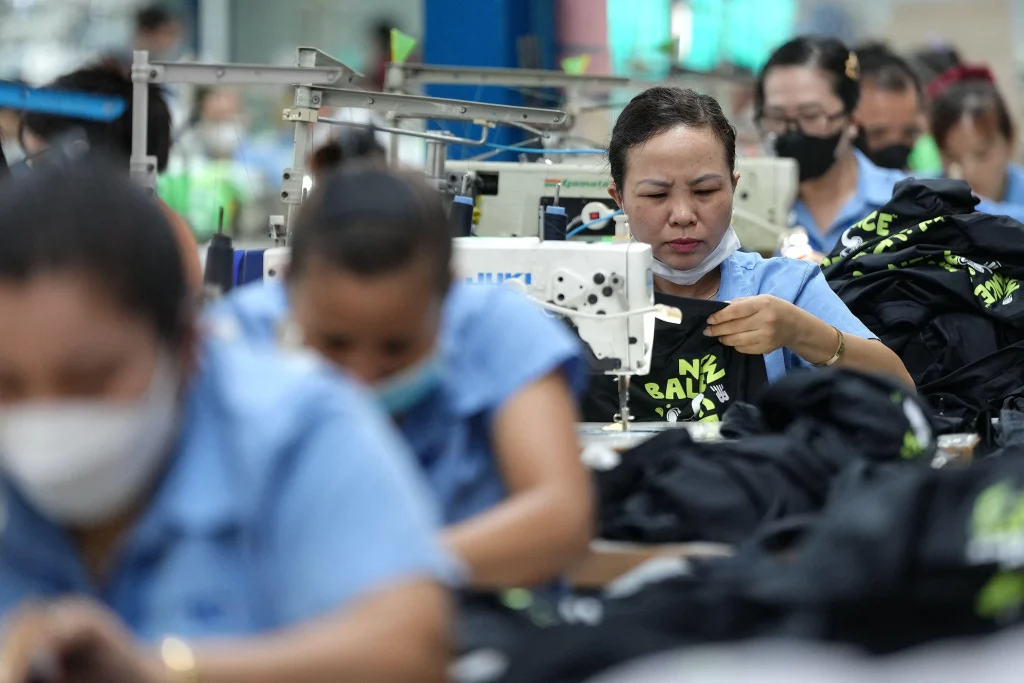[HO CHI MINH CITY] Vietnam’s trade and foreign direct investment (FDI) continued to chart strong growth in May, driven by front-loading demand following the temporary suspension of “Liberation Day” tariffs from the US, Vietnam’s largest export market.
Estimates from the government’s statistics agency (NSO) on Friday (Jun 6) showed that exports rose by 17 per cent year on year to US$39.6 billion, down slightly from the on-year 19.8 per cent rate for April.
Imports rose year on year by 14.1 per cent to US$39.04 billion, also by less than April 22.9 per cent rise on year.
On a monthly basis, exports and imports grew by 5.7 per cent and 5.9 per cent, respectively.
The electronics sector led exports, with a 5.2 per cent monthly increase and a 52.4 per cent year-on-year rise to US$9.2 billion. In contrast, footwear and textiles – also key exports to the US – grew more modestly, by 1.9 per cent and 9.2 per cent, respectively, down from double-digit figures in April.
For the January-to-May period, Vietnam recorded a trade surplus of US$4.67 billion, narrowing from US$8.71 billion in the same period of 2024, with exports and imports rising by 14 per cent and 17.4 per cent, respectively.
A NEWSLETTER FOR YOU

Friday, 8.30 am
Asean Business
Business insights centering on South-east Asia’s fast-growing economies.
Analysts expect front-loading to persist through the second quarter of 2025, with the momentum likely to ease once the US’ 90-day tariff suspension expires in early July.
Vietnam’s industrial production remained healthy, with a 9.4 per cent year-on-year increase in May, though it eased slightly from a 9.6 per cent growth in April. Despite marking the fourth consecutive month of expansion, it was the softest gain since a contraction in January.
Soft data also indicated a contraction in factory activity. The S&P Global Vietnam Purchasing Managers’ Index (PMI) for May recorded its second consecutive month below the 50 threshold, reflecting a slowdown driven by declining new orders amid reduced foreign demand linked to US tariff uncertainties.
Adam Ahmad Samdin, economist at Oxford Economics, also highlighted increasing downside risks to the think tank’s 6.3 per cent year-on-year GDP growth forecast for the country this year.
“The authorities may not be able to come to a deal with the US due to Vietnam’s inherent reliance on Chinese inputs, potentially bringing tariffs back to 46 per cent,” he said.
Reliance on Chinese input
In April, President Donald Trump imposed a 46 per cent “reciprocal” tariff on Vietnam, among the highest among US trading partners. These import taxes have been temporarily reduced to 10 per cent, with a Jul 9 deadline to reach a trade deal.
Reuters reported this week that Washington has sent Hanoi tough requests for tariff discussions, including demands that the South-east Asian country reduce its reliance on materials and components from China.
US Secretary of Commerce Howard Lutnick said on Wednesday that there is still room for talks if Vietnam curtails imports from China and reduces its trade deficit with the US, which amounted to US$123 billion last year.
However, driven by the front-loading surge in the first five months of this year, the South-east Asian country recorded a growing trade surplus with the US – US$49.9 billion, marking a 28.5 per cent year-on-year increase.
Meanwhile, China continued to be the primary source of its imports, comprising 39.5 per cent of the total. This swelled Vietnam’s trade deficit with China to US$45.9 billion, a 40.3 per cent increase from the year-ago period.
Strong FDI from China and Singapore
Realised FDI in Vietnam rose 7.9 per cent year on year to US$8.90 billion from January to May 2025, the highest in the same period in the past five years.
FDI pledges hit US$18.39 billion, marking a 51.2 per cent surge from last year’s figure.
Singapore topped the investor list with over US$4.38 billion in registered FDI, accounting for 23.8 per cent of total foreign inflows; this was 30.1 per cent more than the year before.
South Korea followed with more than US$2.93 billion, making up nearly 16 per cent of the total and marking a 2.47-time rise from the year before.
In terms of new projects, mainland China remained the largest contributor, with 453 projects, up 30 per cent month on month and 2.5 times higher year on year. The value of these projects in the first five months was US$1.81 billion.
Room to support growth
In the domestic sector, Vietnam’s retail sales advanced by 10.2 per cent year on year in May, easing from an almost two-year high of 11.1 per cent in the preceding month.
Headline inflation rose by 3.2 per cent, up from 3.1 per cent in April, still below the 4.75 per cent cap imposed by the State Bank of Vietnam (SBV) .
Samdin said: “This should allow the SBV room for greater monetary easing later in the year, to achieve the ambitious 8 per cent growth target.”
Meanwhile, economists at HSBC Global Research highlighted Vietnam’s fiscal room to support growth, as the South-east Asian country has public debt-to-GDP ratio at around 40 per cent, the lowest in Asean.
They also observed renewed commitment from the authorities to accelerating project implementation and ensuring timely completion, alongside a push to fast-track new transport and energy mega-projects.
They wrote in a May 12 note: “Vietnam is keen to continue with its old playbook of pushing for infrastructure development. (This is able to) kill two birds with one stone by supporting growth while improving infrastructure connectivity.”


